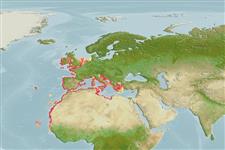Common names from other countries
>
Carangiformes (Jacks) >
Carangidae (Jacks and pompanos) > Naucratinae
Etymology: Campogramma: Greek, kampe, -es = curvature, bent + Greek, gramma = mark, signal, letter (Ref. 45335).
More on author: Lacepède.
Environment: milieu / climate zone / depth range / distribution range
Ecologia
marinhas bentopelágico; intervalo de profundidade 15 - 30 m (Ref. 7097). Subtropical; 56°N - 12°N, 26°W - 27°E
Eastern Atlantic: British Isles to Senegal including Madeira and the Canary Islands. Also western Mediterranean Sea.
Tamanho / Peso / Idade
Maturity: Lm ? range ? - ? cm
Max length : 60.0 cm FL macho/indeterminado; (Ref. 3397); common length : 58.0 cm TL macho/indeterminado; (Ref. 3397); peso máx. publicado: 2.8 kg (Ref. 27584)
Descrição suscinta
Chaves de identificação | Morfologia | Morfometria
Espinhos dorsais (total) : 7; Raios dorsais (total) : 30; Espinhos anais: 2; Raios anais : 23 - 24.
Caught with bottom and pelagic trawls. Adults are pelagic or epibenthic (Ref. 7097) mostly in shallow waters. They feed mainly on schooling fishes (Ref. 4233). Eggs are pelagic (Ref. 4233).
Ciclo de vida ou comportamento de acasalamento
Maturities | Reprodução | Spawnings | Egg(s) | Fecundities | Larvas
Smith-Vaniz, W.F., 1986. Carangidae. p. 815-844. In P.J.P. Whitehead, M.-L. Bauchot, J.-C. Hureau, J. Nielsen and E. Tortonese (eds.) Fishes of the north-eastern Atlantic and the Mediterranean. UNESCO, Paris. vol. 2. (Ref. 4233)
Status na Lista Vermelha da UICN (Ref. 130435)
CITES (Ref. 128078)
Not Evaluated
Ameaça para os humanos
Harmless
Uso pelos humanos
Can't connect to MySQL database (fbapp). Errorcode: Too many connections
